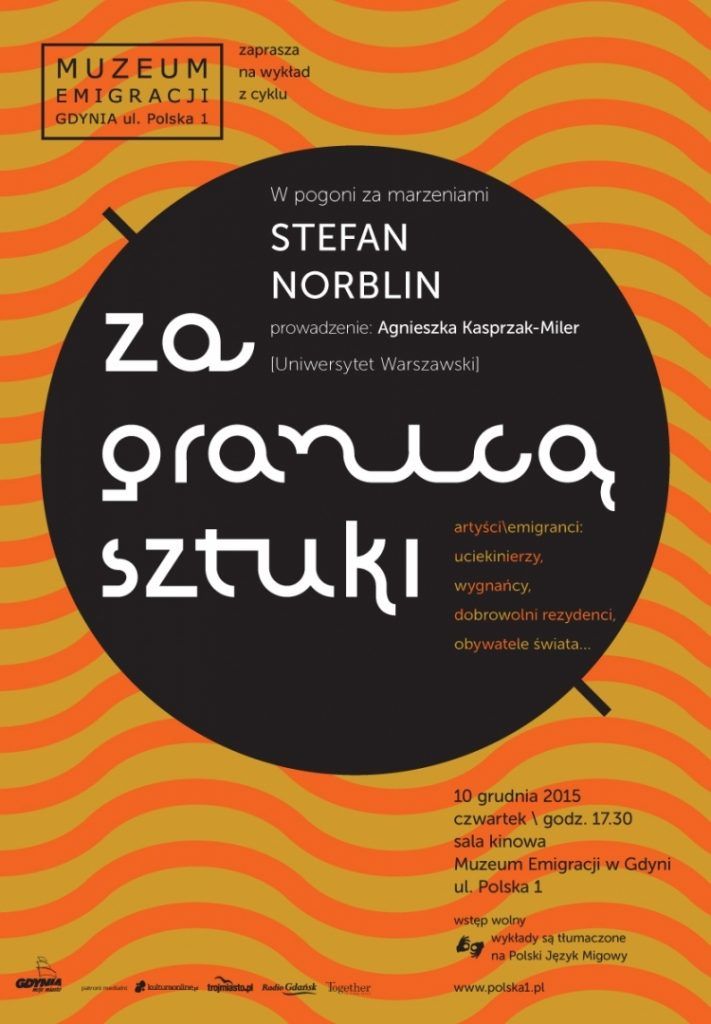From a career as a popular portrait painter in 1930s bohemian Warsaw, through commissions from Indian maharajas, to the long sought-after United States which brought personal and professional disappointment. Stefan Norblin, „an artist of three continents”, will be the subject of a talk by Agnieszka Kasprzak-Miler (Warsaw University), who in 2012 found the artist’s burial place and had his ashes brought to Poland. This third lecture in the series „Across the Borders of Art” on Polish émigré artists will be held on Thursday, 10 December, at 17.30 in the cinema room of the Emigration Museum. The lecture will be translated into Polish Sign Language. Admission free.
Stefan Norblin (1892-1952) was born to a family of Warsaw industrialists, graduated from Antwerp’s Academy of Economy and Trade and took up employment in a paper company. His passion, however, was art. He began by drawing caricatures and portraits, which resulted in his first exhibition in an Amsterdam gallery. He then visited Paris and London, where he produced illustrations under the pseudonym of the”Count von Luxembourg”. In 1920 during the Polish-Soviet war, Norblin allowed himself to be drafted into the army. He took part in the peace conference in Riga as an interpreter (he knew several languages). When he returned to Poland, he became actively involved in the life of Warsaw’s intellectual and artistic élite. His first wife was the actress Maria Modzelewska. In 1933 he married Lena Żelichowska, a dancer at the National Theatre and a popular film actress, with whom he spent the rest of his life. September 1939 brought a halt to Norblin’s artistic successes and he decided to set off, accompanied by his wife, through the Far East (Turkey, Iraq and India) to the United States. In 1946 he and his family settled outside San Francisco, where he became just one of many immigrants and unknown artists. The increasing depression caused by this situation contributed to his death by suicide. Until the 1990s, he was seen only through the prism of his pre-war achievements and works.
The Emigration museum lecture will primarily present the lesser known Asian stage in Stefan Norblin’s artistic output. In the 1990s certain facts unexpectedly came to light which changed our previous knowledge about his life and work. The facts originated in a question posed to Polish diplomats by an English journalist Peter McManus, who was fascinated by the beauty of enormous murals signed „S.NORBLIN” located inside a palace in Jodhpur (India). The interest of this journalist, who was working on a jubilee article about the palace where the walls were adorned with large-scale murals, suddenly opened a new chapter in the artist’s biography. His life and oeuvre, though widely commented on in the 1930s, were almost completely forgotten in post-war criticism. In many compilations and studies devoted to Polish Modern Art, the research and information on Stefan Norblin’s legacy was limited due to censorship and cultural isolation. The conflicting and incomplete information on the artist’s fate after September 1939 was not without significance and his pre-war social contacts, particularly the status of his sitters, were significant in excluding him from post-war compilations. Another contributing factor may have been the lack of access to locations connected with his work (private residences owned by Indian maharajas and their families and inaccessible to the public) or to archive material which could only be brought to light in the new political reality of the 1990s. The current state of research, its results and related conclusions will form the subject of the lecture during which the speaker will take the audience through the palace interiors of the Indian residences which in the 1940s were adorned with pictures and furniture created by Stefan Norblin, an artist being discovered anew.
Agnieszka Kasprzak-Miler – art historian, researcher and author of publications on the subject of goldsmithery and unique jewellery. For a number of years she has been conducting research on Polish art of the interwar period. For many years a Norblin enthusiast, she viewed his Indian works in 2010, from which emerged extensive study and publication. In 2012, during research into the collection of the San Francisco-based Polish Arts and Culture Foundation, which holds some of the artist’s works, she discovered information concerning the artist’s hitherto unknown burial place. Thanks to the assistance of the Consulate General of the Republic of Poland in Los Angeles and the Foundation’s Chairman, as well as permission and authorisation from the artist’s son, Andrew Norblin, she succeeded in bringing the ashes of Stefan Norblin and his wife Lena Żelichowska to Poland where they were interred in the family crypt in the Stare Powązki Cemetery in Warsaw. She has professional experience in conservation work and research which she conducts in Warsaw as an employee of the Metropolitan Monument Conservation Office. Currently a doctoral student at the University of Warsaw.
10.12.2015, Thursday| time: 17.30 | cinema room, Emigration Museum, ul. Polska 1 | admission free| Polish Sign Language translation
More lectures in the series „Across the Borders of Art”:
21.01.2016 | Teresa Żarnowerówna | Ewa Gorządek (Zamek Ujazdowski Centre for Contemporary Art)
11.02.2016 | The Themersons | Professor Zbigniew Majchrowski (Gdańsk University)
10.03.2016 | Jerzy Sołtan | Professor Jacek Dominiczak (Academy of Fine Arts in Gdańsk)
14.04.2016 | Igor Mitoraj | Dr Magdalena Howorus-Czajka (Gdańsk University)
09.06.2016 | Karol Broniatowski | Dr Dorota Grubba-Thiede (Academy of Fine Arts in Gdańsk)


